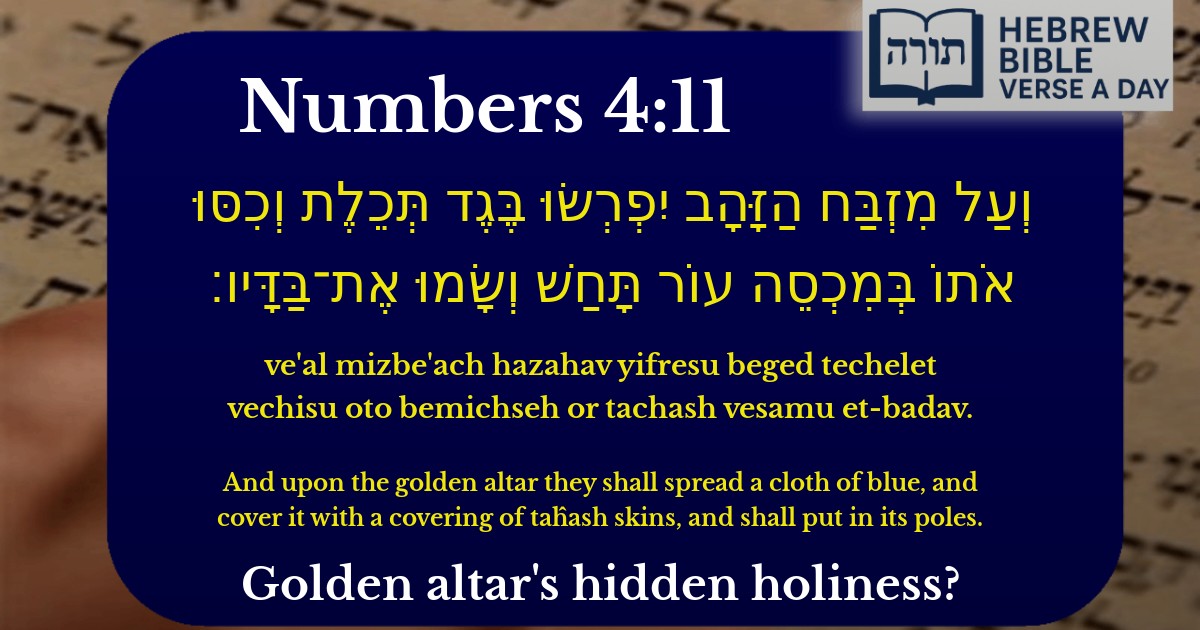Join Our Newsletter To Be Informed When New Videos Are Posted
Join the thousands of fellow Studends who rely on our videos to learn how to read the bible in Hebrew for free!
Hebrew Text
וְעַל מִזְבַּח הַזָּהָב יִפְרְשׂוּ בֶּגֶד תְּכֵלֶת וְכִסּוּ אֹתוֹ בְּמִכְסֵה עוֹר תָּחַשׁ וְשָׂמוּ אֶת־בַּדָּיו׃
English Translation
And upon the golden altar they shall spread a cloth of blue, and cover it with a covering of taĥash skins, and shall put in its poles.
Transliteration
Ve'al mizbe'ach hazahav yifresu beged techelet vechisu oto bemichseh or tachash vesamu et-badav.
Hebrew Leining Text
וְעַ֣ל <b>׀</b> מִזְבַּ֣ח הַזָּהָ֗ב יִפְרְשׂוּ֙ בֶּ֣גֶד תְּכֵ֔לֶת וְכִסּ֣וּ אֹת֔וֹ בְּמִכְסֵ֖ה ע֣וֹר תָּ֑חַשׁ וְשָׂמ֖וּ אֶת־בַּדָּֽיו׃
וְעַ֣ל ׀ מִזְבַּ֣ח הַזָּהָ֗ב יִפְרְשׂוּ֙ בֶּ֣גֶד תְּכֵ֔לֶת וְכִסּ֣וּ אֹת֔וֹ בְּמִכְסֵ֖ה ע֣וֹר תָּ֑חַשׁ וְשָׂמ֖וּ אֶת־בַּדָּֽיו׃
🎵 Listen to leining
Parasha Commentary
📚 Talmud Citations
This verse is quoted in the Talmud.
📖 Yoma 72a
The verse is discussed in the context of the covering of the sacred objects during the transport in the wilderness, particularly focusing on the materials used for covering the golden altar.


Context in the Mishkan
The verse (Shemot 40:5) describes the covering of the golden altar (מִזְבַּח הַזָּהָב) during the transportation of the Mishkan. This altar was used for burning the ketoret (incense) daily. Rashi explains that the golden altar required two coverings: a blue cloth (בֶּגֶד תְּכֵלֶת) underneath and a covering of tachash skins (עוֹר תָּחַשׁ) on top. This parallels the covering of the Aron (Ark), as both were holy vessels requiring special protection.
Symbolism of the Blue Cloth
The color blue (תְּכֵלֶת) is significant in Jewish tradition. The Midrash (Bamidbar Rabbah 4:13) connects it to the heavens and divine revelation. Ramban (Nachmanides) suggests that the blue covering symbolizes the altar's spiritual role in elevating prayers (represented by the ketoret) to the heavens. The Talmud (Menachot 43b) also associates tchelet with the throne of glory, indicating the altar's sacred status.
The Tachash Covering
The outer covering of tachash skins (עוֹר תָּחַשׁ) is discussed in the Talmud (Shabbat 28a), where it is described as a rare, multicolored animal created specifically for the Mishkan's construction. The Kli Yakar (R' Shlomo Ephraim Luntschitz) explains that the tachash covering served as a protective layer, shielding the golden altar from the elements during travel, while its beauty reflected the honor due to the sacred vessel.
Placement of the Poles
The verse concludes with the instruction to place the altar's poles (בַּדָּיו). The Rambam (Hilchot Klei HaMikdash 2:4) notes that unlike the Aron's poles, which were never removed, the golden altar's poles were only inserted when the Mishkan was transported. This teaches that while the altar was stationary during service, its portability emphasized that holiness accompanies Bnei Yisrael wherever they journey.